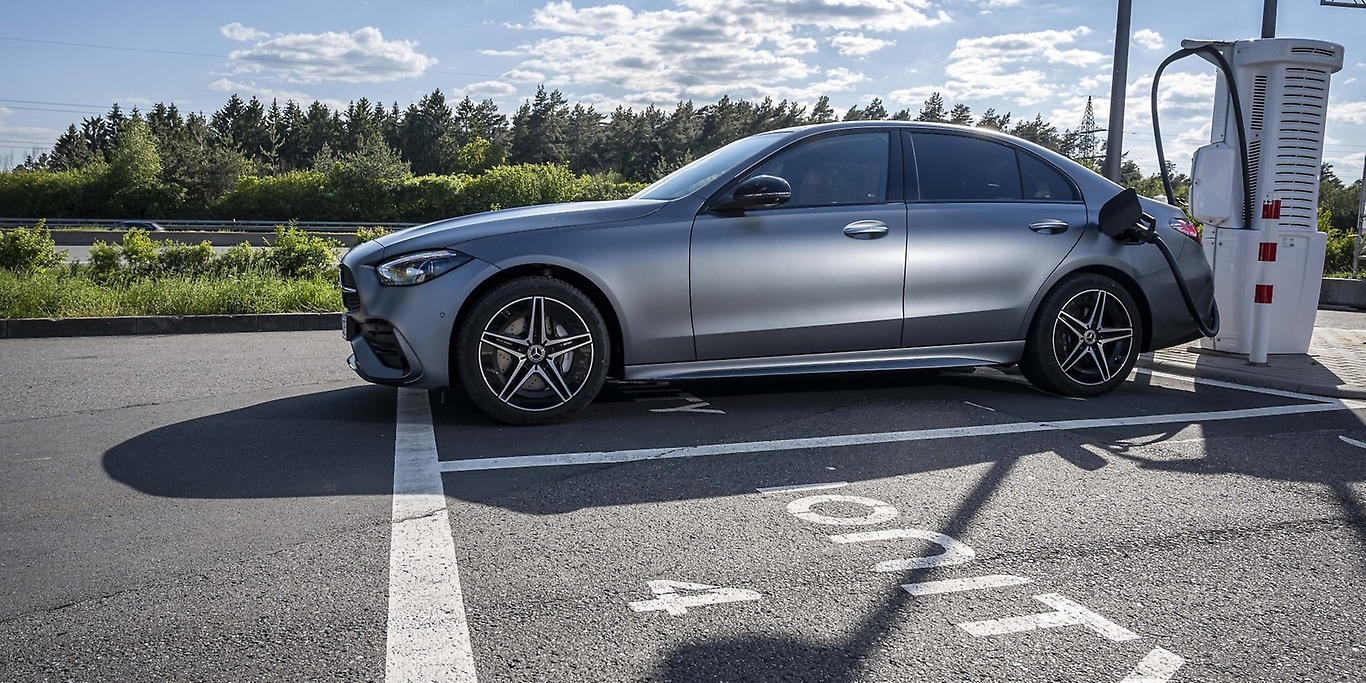Fully electric driving to the city, gym, kindergarten or the supermarket. And long-distance driving with a powerful combustion engine for holiday travels or a spontaneous weekend trip into the mountains. A plug-in hybrid
Easy Tech: Plug-in Hybrid

No compromise: The plug-in hybrid technology.
For many of us, electric cars are not compatible with our everyday needs: we worry about range and the insufficient charging infrastructure. This limitation of our individual mobility contradicts electric driving. Because we do not compromise about a car. But actually, we would not need to: because with plug-in hybrids, we can do both.
10 min reading time
The plug-in hybrid technology: How does it work in Mercedes-Benz compact cars?
In contrast to a conventional combustion engine, plug-in hybrid cars are additionally driven by an electric motor, which obtains its energy from a lithium-ion battery. The battery can be charged both with the combustion engine and at a charging station. That’s where the term Plug-in Hybrid Electric Vehicle (PHEV) originates from and what differentiates the “plug hybrids” from full hybrid vehicles whose battery can only be charged with the combustion engine and through recuperation.


“The Mercedes-Benz compact cars are operated with the third-generation plug-in technology. “, explains Jochen Eck. “It’s primarily characterized by the powerful 75 kW electric motor which is a lot of fun. And the battery which provides an electric range of up to 79 kilometers (NEDC) and thus far enough for your daily commute.” At the same time, the car does not offer significantly less space: the exhaust does not end at the vehicle’s rear but in a centrally positioned outlet under the vehicle floor. The fuel tank is integrated into the rear axle and makes room underneath the rear seats where the battery is built in. That is why the boot capacity is slightly reduced compared to the compact models without hybrid engines. In Jochen Eck’s opinion a “mini-compromise when you consider the number of additional components we had to fit into the plug-in hybrids.”
The Electric Motor
In compact cars, the engines are not installed longitudinally but transversely. The plug-in hybrids have a 1.33-litre four-cylinder engine with an 8G-DCT dual clutch transmission. The electric motor is located between the combustion engine and the transmission. It achieves 75 kW, which, together with the four-cylinder engine, produces a system output of 160 kW (218 hp). The compact hybrids do not have a separate 12-volt starter; the combustion engine is started by the electric motor.
Battery & Chargers
The lithium-ion high-voltage battery is water-cooled and weighs around 150 kg. It has a total capacity of approximately 15.6 kWh and can be charged at an external electric energy source (charging station, wallbox or household socket) with direct current (DC) and alternating current (AC). With DC charging, the battery can be charged from 10 to 80 percent SoC (Status of Charge defines the charging status in relation to the battery capacity) in around 25 minutes. With AC charging at a 7.4 kW wallbox, the battery can be charged within 1 hour and 45 minutes from 10 to 100 percent SoC. Thus charging is easily integrated into everyday life – as long as the supermarket, city car park or employee parking space offers (sufficient) charging stations. At home, the battery can be fully recharged at a conventional household socket within 5 hours.
But how does the electrical power transfer from the energy source to the battery? With the chargers installed in the vehicle: a 7.4 kW AC charger converts the absorbed alternating current from household socket, Wallbox or charging station to direct current and charges the battery with a charging capacity of up to 7.4 kW. Fun-tech-fact: the charging capacity of a conventional smartphone charger is about 18 watts. Thus, the charging capacity of a 7.4 kW AC charger corresponds to about 411 smartphone chargers.
When time is of the essence, the DC charger offers the possibility to charge the battery with the more powerful direct current (DC). In this case, the direct current transfers directly from a DC fast charging station to the battery – the DC charger only communicates with the charging station and adjusts the direct current to a charging capacity of up to 24 kW.
Power Electronics & DC/DC Converter
The control center between electric motor and battery are the so-called power electronics with an integrated DC/DC Converter, also called direct current converter. Thanks to the chargers, the electrical power is now saved inside the battery. The task of power electronics and DC/DC Converter is to provide this electrical power for two different electric circuits: on the one hand for the 12-voltage on-board electrical system which supplies consumers such as MBUX, the electric pre-entry climatisation or the headlamps. And on the other hand for the high-voltage circuit which not only provides the power for the electric motor and thus generates the propulsion. But also converts braking energy into electrical power in order to charge the battery. Depending on its purpose, the power electronics and the DC/DC Converter convert the direct current voltage into an either higher (400V) or lower (12V) voltage level.
Efficient Electric Performance
“Our compact cars with EQ Power are very efficient overall,” says Jochen Eck. “Not only because of the power of the electric motor and the battery but also because we use both components for recuperation.” Recuperation means brake energy regeneration, which makes it possible to recharge the battery while driving: when braking or coasting, the energy is recovered and stored in the battery. In total, the plug-in hybrids have five different drive programs. In Comfort, the emphasis is on driving dynamics in a combined drive mode and in ECO, electric driving is prioritized. In Sport, driving with the combustion engine is preferred. If you need to save electric range on a long-distance trip, e.g. for an electric city drive at your destination, the drive mode Battery Level keeps the battery’s status of charge constant by only using the combustion engine.
Maximum electric performance is available in the drive mode Electric with fully electric driving. The combustion engine is only engaged if the driver makes a kickdown, for instance. Furthermore, five different recuperation levels can be selected individually with the steering wheel paddles: DAUTO, D+, D, D- and D--. Jochen Eck suggests: “Especially for everyday driving DAUTO is very comfortable as the driver can completely leave recuperation to the vehicle. It automatically decides whether recuperation is feasible and if so, in which level. Depending on vehicles ahead, which are constantly monitored via radar.”
The Intelligent Operating Strategy
Leaving consideration to the car is also possible with the intelligent, route-based operating strategy. Based on navigation data, topography, speed limits and traffic conditions, it decides which sections along the planned route are most appropriate for electric driving and which ones are not. Jochen Eck explains: “Enter the destination into your navigation system and hit the road. The vehicle will automatically select the most efficient operating strategy: for driving on the motorway, the combustion engine is selected, for city driving the battery comes first. Always aiming to reach the vehicle’s maximum efficiency.” Furthermore, MBUX supports the driver in finding a charging station – either along the route or at the destination. “This makes your experience in a plug-in hybrid even more convenient.”, says Jochen Eck.
No matter whether long- or short-distance driving: the compact plug-in hybrids are efficient and intelligent – not despite, but due to the electric drive. Thus, we do not need to compromise about electric mobility.
¹The stated figures are the measured "NEDC CO₂ figures" in accordance with Art. 2 No. 1 Implementing Regulation (EU) 2017/1153. The fuel consumption figures were calculated based on these figures. The range and the electrical consumption have been determined on the basis of Regulation (EC) No. 692/2008.*


















